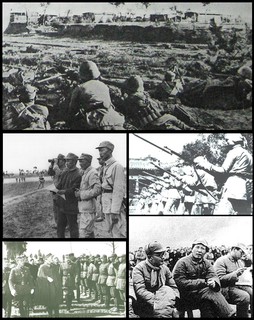
The Chinese Civil War was fought between the Kuomintang-led government of the Republic of China and forces of the Chinese Communist Party, continuing intermittently since 1st August 1927 until 7th December 1949 with a Communist victory on mainland China.
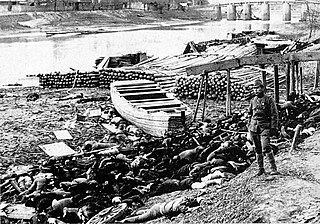
The Nanjing Massacre or the Rape of Nanjing was the mass murder of Chinese civilians in Nanjing, the capital of the Republic of China, immediately after the Battle of Nanking in the Second Sino-Japanese War, by the Imperial Japanese Army. Beginning on December 13, 1937, the massacre lasted six weeks. The perpetrators also committed other war crimes such as mass rape, looting, and arson. The massacre was one of the worst atrocities committed during World War II.

The Battle of Nanking was fought in early December 1937 during the Second Sino-Japanese War between the Chinese National Revolutionary Army and the Imperial Japanese Army for control of Nanking (Nanjing), the capital of the Republic of China.

The Second Sino-Japanese War (1937–1945) or War of Resistance was a military conflict that was primarily waged between the Republic of China and the Empire of Japan. The war made up the Chinese theater of the wider Pacific Theater of the Second World War. The beginning of the war is conventionally dated to the Marco Polo Bridge Incident on 7 July 1937, when a dispute between Japanese and Chinese troops in Peking escalated into a full-scale invasion. Some Chinese historians believe that the Japanese invasion of Manchuria on 18 September 1931 marks the start of the war. This full-scale war between the Chinese and the Empire of Japan is often regarded as the beginning of World War II in Asia.

Inukai Tsuyoshi was a Japanese politician, cabinet minister, and Prime Minister of Japan from 1931 to his assassination in 1932. Inukai was Japan's second oldest prime minister while serving, as he was aged 76 on the day he was murdered, after Kantarō Suzuki.

Shanghai Hongqiao International Airport is one of the two international airports of Shanghai and a significant airline hub of China. Hongqiao Airport mainly serves domestic and regional flights, although the airport also serves international flights. The airport is located near the town of Hongqiao in Changning District and Minhang District, 13 kilometres (8.1 mi) west of downtown, and is closer to the city center than the area's primary international airport, Shanghai Pudong.

The Mukden Incident, or Manchurian Incident, known in Chinese as the 9.18 Incident (九・一八), was a false flag event staged by Japanese military personnel as a pretext for the 1931 Japanese invasion of Manchuria.

Mamoru Shigemitsu was a Japanese diplomat and politician in the Empire of Japan, who served as Minister of Foreign Affairs three times during and after World War II as well as the Deputy Prime Minister of Japan. As civilian plenipotentiary representing the Japanese government, Shigemitsu co-signed the Japanese Instrument of Surrender on board the battleship USS Missouri on September 2, 1945.

The Battle of Shanghai was the first of the twenty-two major engagements fought between the National Revolutionary Army (NRA) of the Republic of China (ROC) and the Imperial Japanese Army (IJA) of the Empire of Japan at the beginning of the Second Sino-Japanese War. It lasted from August 13, 1937, to November 26, 1937, and was one of the largest and bloodiest battles of the entire war, later described as "Stalingrad on the Yangtze", and is often regarded as the battle where World War II started. After over three months of extensive fighting on land, in the air and at sea, the battle concluded with a victory for Japan.

Yun Bong-gil was a Korean independence activist who set off a bomb that killed several Japanese dignitaries in Shanghai's Hongkew Park in 1932. He was posthumously awarded the Republic of Korea Medal of Order of Merit for National Foundation in 1962 by the South Korean government.
This article is concerned with the events that preceded World War II in Asia.

The January 28 incident or Shanghai incident was a conflict between the Republic of China and the Empire of Japan. It took place in the Shanghai International Settlement which was under international control. Japanese army officers, defying higher authorities, had provoked anti-Japanese demonstrations in the International Settlement following the Japanese invasion of Manchuria. The Japanese government sent a sect of militant ultranationalist Japanese Buddhist priests belonging to the Nichiren sect to Shanghai. The monks shouted anti-Chinese, pro-Japanese nationalist slogans in Shanghai, promoting Japanese rule over East Asia. In response, a Chinese mob formed killing one monk and injuring two. In response, the Japanese in Shanghai rioted and burned down a factory, killing two Chinese. Heavy fighting broke out, and China appealed with no success to the League of Nations. A truce was finally reached on May 5, calling for Japanese military withdrawal, and an end to Chinese boycotts of Japanese products.
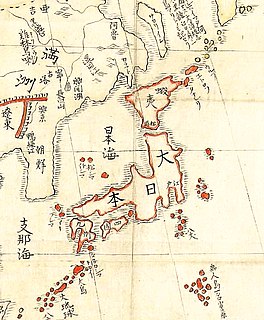
Japanese militarism refers to the ideology in the Empire of Japan which advocates the belief that militarism should dominate the political and social life of the nation, and the belief that the strength of the military is equal to the strength of a nation.
Sun Yuanliang was a Chinese military general of the National Revolutionary Army of the Republic of China. Sun was the last surviving member of the first graduating class of the Whampoa Military Academy, as well as the last surviving army-level commander of the Second Sino-Japanese War. His career spanned the January 28 Incident, Second Sino-Japanese War and the Chinese Civil War.

Yasuji Okamura was a general of the Imperial Japanese Army, and commander-in-chief of the China Expeditionary Army from November 1944 to the end of World War II. He was tried but found not guilty of any war crimes by the Shanghai War Crimes Tribunal after the war. As one of the Imperial Japanese Army's top China experts, General Okamura spent his entire military career on the Asian mainland.
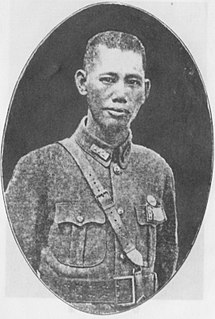
Cai Tingkai was a Chinese general.
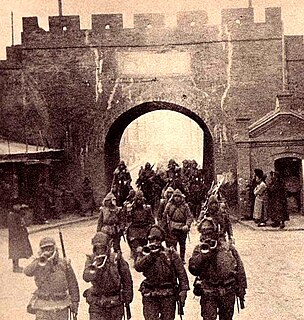
The Empire of Japan's Kwantung Army invaded Manchuria on 18 September 1931, immediately following the Mukden Incident. At the war's end in February 1932, the Japanese established the puppet state of Manchukuo. Their occupation lasted until the success of the Soviet Union and Mongolia with the Manchurian Strategic Offensive Operation in mid-August 1945, towards the end of the Second World War.
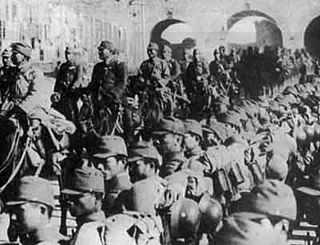
The Shanghai Expeditionary Army was a corps-level ad hoc Japanese army in the Second Sino-Japanese War.

The Marco Polo Bridge Incident, also known as the Lugou Bridge Incident or the July 7 Incident, was a July 1937 battle between China's National Revolutionary Army and the Imperial Japanese Army.

Naozaburō Okabe was a General in the Imperial Japanese Army, who commanded the Japanese Sixth Area Army from November 1944 until the end of World War II.